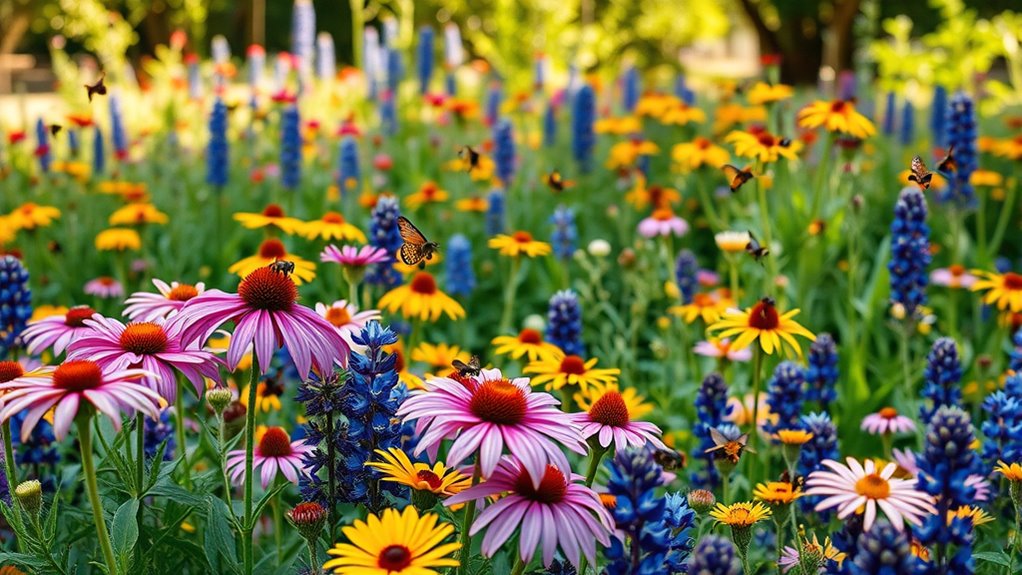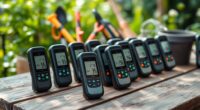I’ve found that choosing native pollinator seed mixes for your garden is one of the best ways to attract bees, butterflies, and hummingbirds. The top options, like mixes from Iowa, Missouri, Michigan, and Georgia, include native, non-GMO species tailored for your region. These mixes support continuous blooms and ecosystem health. If you want to learn which mixes suit your area and get tips for successful planting, keep exploring further.
Key Takeaways
- Select mixes with diverse native, non-GMO species that bloom from spring to fall for continuous pollinator nectar.
- Choose region-specific mixes tailored to your USDA zone and soil type for optimal growth and pollinator support.
- Opt for high-quality seed blends with native flowers like Black-Eyed Susan and Purple Coneflower to attract bees, butterflies, and hummingbirds.
- Prioritize mixes that include a variety of perennial and annual species for long-lasting garden buzz.
- Consider mixes with seed coatings and soil conditioners to improve establishment and ensure vibrant, pollinator-friendly blooms.
Iowa Wildflower Seed Mix, 1lb

Are you looking to create a vibrant, pollinator-friendly garden that covers a large area with minimal effort? The Iowa Wildflower Seed Mix, 1lb, is perfect for that. It covers about 2,000 square feet and includes 16 easy-to-grow, non-GMO species like Black-Eyed Susan, Purple Coneflower, and Scarlet Sage. These colorful blooms attract bees, butterflies, and other pollinators, boosting biodiversity. Suitable for spring and fall planting in the Midwest, it requires no fertilizers and comes in eco-friendly packaging. With this mix, you can effortlessly enhance your landscape’s beauty and support local pollinator populations.
Best For: gardeners and landscapers seeking to create large, colorful, pollinator-friendly wildflower gardens with minimal effort and eco-conscious practices.
Pros:
- Covers up to 2,000 sq ft, ideal for large areas and meadow restoration.
- Contains 16 easy-to-grow, non-GMO native species that attract pollinators and promote biodiversity.
- Packaged with earth-friendly materials, supporting sustainable gardening efforts.
Cons:
- Best results require planting in spring or fall; unsuitable for summer planting.
- May need supplemental watering in dry conditions to ensure germination.
- Limited to Midwest US regions, reducing suitability for other climates.
Missouri Wildflower Seed Mix (1lb)

If you’re passionate about supporting local pollinators and creating a vibrant, eco-friendly garden, the Missouri Wildflower Seed Mix (1lb) is an excellent choice. Covering 2,000 square feet, it features 16 easy-to-grow native species like coneflowers, coreopsis, black-eyed Susan, and salvia, all designed to attract bees, butterflies, and other pollinators. The seeds are 100% pure, non-GMO, with no fillers, ensuring quality and ecological value. Suitable for planting in spring or fall, this mix thrives in full or partial sun across Missouri and surrounding states. Packaged sustainably, it’s a simple way to enhance your garden’s beauty and support native ecosystems.
Best For: gardeners and conservation enthusiasts looking to support native pollinators and create sustainable, colorful wildflower gardens in the Midwest and surrounding regions.
Pros:
- Contains 16 native, easy-to-grow species that attract pollinators like bees and butterflies.
- 100% pure, non-GMO seeds with no fillers, ensuring high quality and ecological integrity.
- Covers up to 2,000 sq ft, making it cost-effective for large planting areas.
Cons:
- Optimal growth requires full or partial sun; shaded areas may not perform well.
- Best planted in spring or fall; planting outside these seasons may reduce germination success.
- May require ongoing maintenance to control weeds and encourage wildflower diversity.
Michigan Bulk Perennial Wildflower Seed Mix (1lb)

Looking to support local pollinators while adding vibrant color to your landscape? The Michigan Bulk Perennial Wildflower Seed Mix (1lb) is an excellent choice. It contains 100% pure, non-GMO seeds with no fillers, featuring 16 easy-to-grow species like Purple Coneflower, Black-Eyed Susan, and Scarlet Sage. Covering about 2,000 sq ft, it’s perfect for wildflower gardens, roadside plantings, or naturalized areas in the Midwest. These multi-color blooms attract bees, butterflies, and beneficial insects, supporting local biodiversity. Plant in spring or fall, and enjoy a low-maintenance, eco-friendly way to enhance your garden’s beauty and ecosystem health.
Best For: gardeners and environmental enthusiasts in the Midwest seeking to create sustainable, vibrant wildflower habitats that support pollinators and enhance biodiversity.
Pros:
- Contains 100% pure, non-GMO seeds with no fillers, ensuring quality and purity.
- Supports pollinator health by attracting bees, butterflies, and beneficial insects.
- Covers approximately 2,000 sq ft, making it cost-effective for large areas.
Cons:
- Optimal growth requires proper soil preparation and adequate sunlight, which may require extra effort.
- Best planted in spring or fall, limiting planting windows in some regions.
- May take time to establish fully and reach peak bloom, requiring patience.
Georgia Wildflower Seed Mix (1lb) for Pollinators and US Southeast Planting

The Georgia Wildflower Seed Mix (1lb) is an excellent choice for gardeners and conservationists aiming to attract pollinators while enhancing their outdoor spaces in the Southeast US. It covers 2,000 square feet and includes 16 native species like Purple Coneflower, Black-Eyed Susan, and Lemon Mint, providing vibrant spring and fall blooms. Made from 100% pure, non-GMO seeds, it’s easy to grow with moderate watering and full or partial sun. This mix promotes biodiversity by attracting bees, butterflies, and hummingbirds, supporting local ecosystems. Despite some mixed reviews on germination, it remains a popular option for adding seasonal color and ecological benefits to your garden.
Best For: gardeners, conservationists, and outdoor enthusiasts in the Southeast US seeking to attract pollinators and add seasonal color with native wildflowers.
Pros:
- Contains 16 native, colorful species to promote biodiversity and support local ecosystems.
- Easy to grow with moderate watering and suitable for full or partial sun exposure.
- Covers a large area (2,000 sq ft) with a 1lb seed mix, offering good value for garden and landscape enhancement.
Cons:
- Mixed reviews on germination success, with some users experiencing poor or no plant growth.
- Potential issues with seed viability or planting timing that may affect results.
- Some customers consider the product a waste if seeds do not sprout despite proper care.
Wildflower Seeds Bulk, 2 Oz. (80,000+ Seeds) Bee-Friendly Wildflower Mix

Wildflower Seeds Bulk, 2 Oz., is an excellent choice for gardeners and conservation enthusiasts aiming to support pollinator populations. This mix contains over 80,000 non-GMO seeds, including 19 varieties like Coneflowers, Butterfly Milkweed, and Cosmos, covering approximately 250 square feet. It’s easy to grow—just sow outdoors after the last frost or in fall—and attracts bees, butterflies, and hummingbirds. Packaged in a stylish, resealable bag, it’s perfect for gifting or community projects. With quick germination and vibrant blooms, it helps boost biodiversity while supporting bee conservation efforts. Plus, it’s a fun, eco-friendly way to transform your garden into a pollinator haven.
Best For: gardeners, conservationists, and community organizers looking to support pollinator health and biodiversity with an easy-to-grow, eco-friendly wildflower seed mix.
Pros:
- Contains over 80,000 non-GMO seeds with 19 diverse wildflower varieties suitable for attracting bees, butterflies, and hummingbirds.
- Easy to plant and quick to germinate, with blooms appearing within approximately 3 weeks.
- Packaged in an attractive, resealable bag making it ideal for gifting, educational projects, and community initiatives.
Cons:
- May attract invasive Japanese Hops sprouts, requiring vigilance in garden maintenance.
- Requires full sun and well-drained soil for optimal growth, limiting some planting locations.
- Some users may experience variability in germination time depending on environmental conditions.
Eden Brothers Midwest Wildflower Mixed Seeds (1/4 lb)

If you’re seeking an easy way to boost your garden’s ecological health, Eden Brothers Midwest Wildflower Mixed Seeds is an excellent choice, especially for those in USDA zones 3-10. This 1/4 lb package contains 100% pure, non-GMO seeds with no fillers, featuring 25 easy-to-grow species like Black Eyed Susan, Coneflower, Lupine, and Coreopsis. These seeds offer high germination rates and thrive in full sun, covering 250-500 sq ft. They attract pollinators like bees, butterflies, and hummingbirds, supporting local biodiversity. Perfect for spring or fall planting, this mix brings vibrant, mixed-color blooms early in the season and requires minimal maintenance.
Best For: gardeners and eco-conscious homeowners in USDA zones 3-10 seeking an easy, sustainable way to enhance their outdoor space with vibrant, pollinator-friendly wildflowers.
Pros:
- Contains 100% pure, non-GMO seeds with no fillers, ensuring high quality and reliability.
- Attracts pollinators such as bees, butterflies, and hummingbirds, supporting local biodiversity.
- Covers 250-500 sq ft with vibrant, mixed-color blooms, providing lasting outdoor beauty.
Cons:
- May require specific planting conditions for optimal germination and growth.
- Includes a mixture of annual and perennial species, which may have different maintenance needs.
- Availability of certain species might vary over time, affecting the exact plant composition.
Hale Habitat & Seed Native Grass & Wildflower Refuge Seed Mix

For those seeking to restore prairie habitats and support native pollinators, the Hale Habitat & Seed Native Grass & Wildflower Refuge Seed Mix offers an ideal solution. This 1/4-acre mix combines six native grasses and twelve wildflowers that bloom from spring to fall, attracting pollinators and providing wildlife cover. Composed of big bluestem, sideoats grama, switchgrass, and vibrant wildflowers like Black-eyed Susan and Purple Prairie Clover, it’s perfect for sunny, sandy soils. Seeding is simple—just 2.5 pounds of seed for a quarter-acre area, with planting during spring or fall. It’s a sustainable way to boost biodiversity and restore native prairie landscapes.
Best For: gardeners, landscapers, or conservationists looking to restore prairie habitats, attract pollinators, and support native wildlife with native grasses and wildflowers.
Pros:
- Includes a diverse mix of native grasses and wildflowers that bloom from spring to fall, attracting pollinators throughout the growing season.
- Easy to plant with a simple seeding process, requiring only 2.5 pounds of seed per quarter-acre area and planting during spring or fall.
- Supports biodiversity and wildlife habitat restoration by providing cover, food, and pollinator benefits in sunny, sandy soils.
Cons:
- May require moderate watering and specific soil conditions (sandy soil) for optimal growth.
- The height of mature plants can reach up to 8 feet, which might not suit all landscape designs.
- The product has mixed customer ratings (4.0 out of 5 stars), indicating some users may have experienced varying results or challenges in establishment.
Seed Needs Pollinator Seed Mix Honey Bee Blend Wildflowers
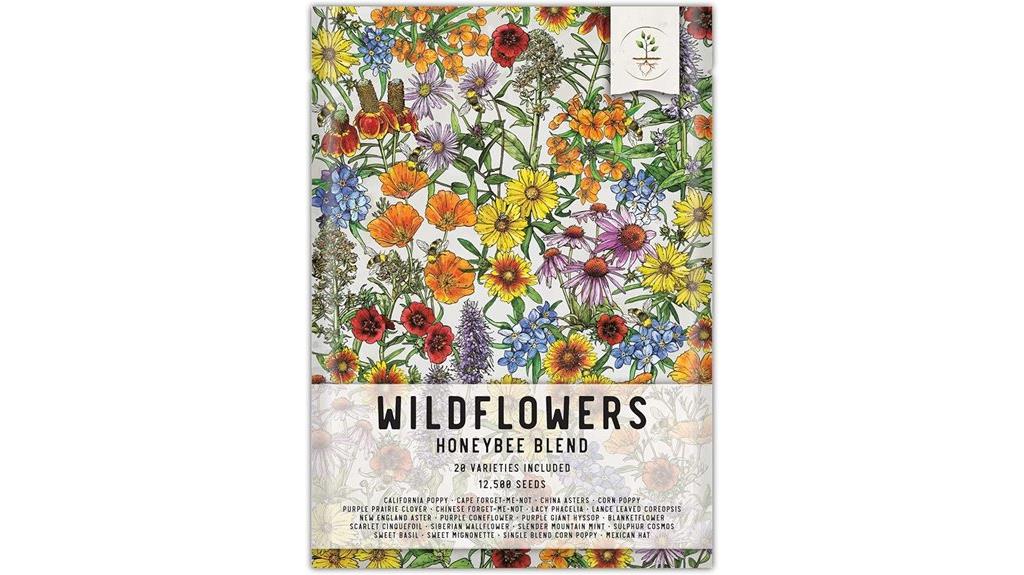
The Seed Needs Pollinator Seed Mix Honey Bee Blend Wildflowers is an excellent choice for gardeners aiming to attract and support pollinators like bees and butterflies. It includes over 12,500 heirloom, non-GMO wildflower seeds from 16 perennial species, such as Black-Eyed Susan and Purple Coneflower, designed to bloom from summer to fall. These hardy, low-maintenance plants thrive in full sun and average soil across USDA zones 1-10, with plants reaching up to 60 inches. The mix reseeds naturally, providing ongoing blooms that enhance local ecosystems and support pollinator populations while adding vibrant color to your garden.
Best For: gardeners and environmental enthusiasts seeking to attract pollinators, support local ecosystems, and create vibrant, low-maintenance wildflower gardens.
Pros:
- High germination rate with quick sprouting and abundant blooms
- Includes over 16 perennial, heirloom, non-GMO wildflower species for diverse and colorful displays
- Supports pollinators like bees and butterflies while promoting sustainable gardening
Cons:
- Requires consistent moisture and proper timing for optimal germination
- Plants may take time to reach full height and bloom, depending on growing conditions
- Initial flower color or quantity may vary, requiring patience and proper site preparation
California Wildflower Mix – 10,000 Seeds, 17 Varieties, Non-GMO Perennial & Annual Flowers

Native pollinator seed mixes like the California Wildflower Mix are ideal for gardeners seeking to boost local biodiversity and attract bees and butterflies. This mix includes 10,000 non-GMO seeds from 17 native perennial and annual flower varieties, such as poppies, lupines, and daisies. It’s easy to grow, requires full sun, and blooms from summer to fall, drawing pollinators to your garden. The seeds germinate quickly, often within three days, and adapt well to various environments, including hillsides. With positive reviews and a resealable package, this mix offers a low-maintenance way to create a vibrant, pollinator-friendly landscape.
Best For: gardeners and nature enthusiasts looking to enhance local biodiversity, attract pollinators, and establish low-maintenance, vibrant wildflower gardens in various outdoor settings.
Pros:
- Contains 17 native varieties, including poppies, lupines, and daisies, for diverse blooms.
- Non-GMO, filler-free seeds sourced from the USA, ensuring quality and ecological safety.
- Easy to grow with quick germination, suitable for both beginners and experienced gardeners.
Cons:
- Germination can be slow or variable, sometimes taking longer than three days or resulting in fewer sprouts.
- Results may vary depending on environmental conditions, with some users experiencing limited growth.
- Blooming may be delayed into late summer or early fall, which might not align with all gardening timelines.
Earth Science Wildflower Pollinator Mix (6 lbs)
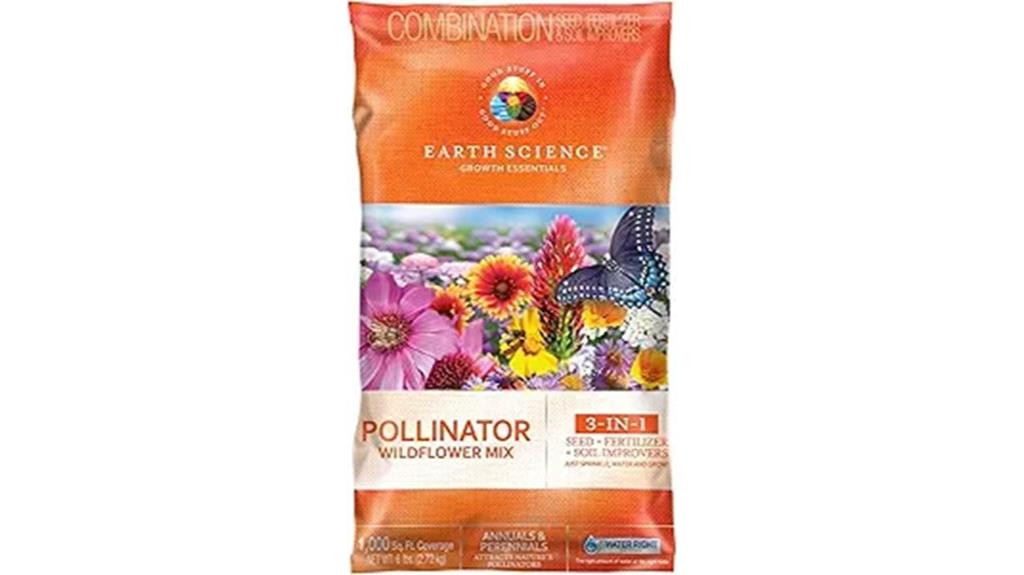
If you’re looking to create a vibrant, pollinator-friendly garden with minimal effort, the Earth Science Wildflower Pollinator Mix is an excellent choice. This 6-pound bag covers about 1,000 square feet and combines wildflower seeds, mulch, plant food, and soil conditioners into one easy package. It features 13 species, including annuals and perennials like coneflowers, zinnias, and rocket larkspur, designed to attract bees, butterflies, and hummingbirds. It’s non-GMO, organic, and free from harmful chemicals, making it safe for people, pets, and wildlife. Simply water regularly, and the included Water Right Crystals will help you know when to hydrate for continuous, colorful blooms.
Best For: gardeners and landscape enthusiasts seeking an easy, eco-friendly way to attract pollinators and create a colorful, sustainable habitat with minimal maintenance.
Pros:
- Combines wildflower seeds, mulch, plant food, and soil conditioners in one convenient package
- Supports pollinators like bees, butterflies, and hummingbirds for a thriving garden ecosystem
- Made from organic, non-GMO ingredients free from harmful chemicals and pesticides
Cons:
- Coverage may vary depending on soil quality and planting conditions
- Requires regular watering and maintenance to ensure optimal growth
- Limited to approximately 1,000 square feet coverage per 6-pound bag
Midwest US Wildflower Seed Mix (1 lb)

Looking to create a vibrant, pollinator-friendly garden that supports local ecosystems? The Midwest US Wildflower Seed Mix (1 lb) is perfect for that. It’s made of 100% pure, non-GMO seeds, including 16 easy-to-grow species like Black-Eyed Susan, Purple Coneflower, and Scarlet Flax. This mix offers both annual and perennial wildflowers, attracting bees, butterflies, and other pollinators while boosting biodiversity. Covering about 2,000 square feet, it’s suitable for spring or fall planting in Midwestern states and nearby regions. Plus, its eco-friendly packaging makes it an excellent, low-maintenance choice for gardeners wanting natural beauty and ecological support.
Best For: Gardeners and conservation enthusiasts seeking an easy, eco-friendly way to create colorful, pollinator-friendly landscapes that support local ecosystems.
Pros:
- Contains 16 native, easy-to-grow wildflower species that attract bees and butterflies.
- Covers approximately 2,000 square feet with just 1 pound of seed, ideal for large areas.
- Made from 100% pure, non-GMO seeds with no fillers, ensuring high germination and purity.
Cons:
- Best suited for planting in spring or fall; less effective during hot summer months.
- May require minimal ongoing maintenance to ensure successful growth.
- Not suitable for regions outside the Midwestern US and nearby Canadian provinces without adaptation.
65,000+ Seeds Honey Bee Wildflower Pollinator Mix

The 65,000+ Seeds Honey Bee Wildflower Pollinator Mix is an ideal choice for gardeners and conservation enthusiasts who want to support bee populations and enhance pollination in their outdoor spaces. This mix features over 65,000 pure seeds, including 50% perennials and 50% annuals like California Poppy, Bergamot, Lemon Queen Sunflower, and Purple Coneflower. Designed for spring and fall planting, it attracts bees, butterflies, and birds, boosting garden biodiversity. Created by bee lovers, the mix not only supports pollinator health but also contributes to ecological balance. Plus, the company donates annually to environmental and bee conservation efforts, making it a meaningful addition to any garden.
Best For: gardeners, conservationists, and bee enthusiasts looking to support pollinator health and increase biodiversity in outdoor spaces.
Pros:
- Supports pollinator health by attracting bees, butterflies, and birds.
- Includes a diverse mix of over 65,000 pure seeds with both perennial and annual varieties.
- Promotes ecological balance and colorful blooms from spring to fall.
Cons:
- Requires outdoor planting in suitable USDA zones for optimal growth.
- May need periodic maintenance to ensure successful germination and growth.
- As a seed mix, results can vary based on local soil and climate conditions.
Minnesota Wildflower Seed Mix (1lb)

Minnesota Wildflower Seed Mix (1lb) stands out as an excellent choice for eco-conscious gardeners aiming to attract native pollinators across the Midwest and parts of Canada. This 1-pound mix covers 2,000 square feet and features 16 vibrant, easy-to-grow, non-GMO seeds. It includes species like Black-Eyed Susan, Purple Coneflower, and Scarlet Flax, providing a diverse array of blooms from spring through fall. Perfect for full or partial sun, it thrives in various zones, including Minnesota, Illinois, and Ontario. Packaged sustainably, it promotes eco-friendly gardening and supports local pollinator populations, making your garden a lively, buzzing haven.
Best For: eco-conscious gardeners in the Midwest and Canadian regions seeking to attract pollinators and create vibrant native wildflower gardens.
Pros:
- Contains 16 diverse, non-GMO, easy-to-grow seed varieties that support local pollinators.
- Covers 2,000 sq-ft with just 1lb, making it cost-effective and ideal for large planting areas.
- Packaged in eco-friendly materials, promoting environmentally sustainable gardening practices.
Cons:
- Requires full or partial sun, limiting use in shaded garden areas.
- Optimal planting during spring and fall may not suit all gardening schedules.
- Plant height up to 24 inches may be unsuitable for low-growing garden designs.
Eastern Kansas Wildflower Seed Mix (1lb)

If you’re aiming to boost pollinator activity and add vibrant native blooms to your landscape, the Eastern Kansas Wildflower Seed Mix is an excellent choice. This 1-pound mix covers about 2,000 square feet and features 16 native species that attract bees, butterflies, and other pollinators. It includes a diverse blend of annuals and perennials like Purple Coneflower, Black-Eyed Susan, and Lupine, which thrive in various soil types. Perfect for spring and fall planting, it supports native biodiversity and enhances your garden’s beauty. Packaged in eco-friendly materials, this mix promotes ecological health while creating a stunning, pollinator-friendly habitat.
Best For: gardeners, landscapers, and restoration projects seeking to attract pollinators and enhance biodiversity with native wildflowers in the Eastern Kansas region.
Pros:
- Contains 16 native, easy-to-grow species that support pollinator populations.
- Covers approximately 2,000 sq ft with just 1 lb of seed, offering good value.
- Packaged in eco-friendly materials, promoting sustainable gardening practices.
Cons:
- Optimal results require proper soil preparation and timing during spring or fall planting.
- May need ongoing maintenance or supplemental watering in dry conditions.
- Some species may take multiple seasons to fully establish and bloom.
Burpee Wildflower 25,000 Bulk Pollinator Garden Seeds

For gardeners looking to support pollinator populations across a large area, Burpee Wildflower 25,000 Bulk Seeds offers an excellent solution. This mix includes 18 vibrant varieties like Echinacea, Blue Flax, and Chinese Aster, designed to attract bees, butterflies, and hummingbirds. Covering up to 1,000 square feet, it’s perfect for sunny spots and most soil types. Easy to sow, these non-GMO seeds have a germination rate 35% higher than industry standards, ensuring a lush, colorful wildflower display throughout the season. With Burpee’s trusted reputation, you can confidently create a thriving habitat for pollinators while enhancing your garden’s beauty.
Best For: gardeners seeking to support pollinator populations over large areas with vibrant, easy-to-grow wildflowers.
Pros:
- Contains 18 diverse wildflower varieties to attract bees, butterflies, and hummingbirds.
- Covers up to 1,000 square feet, ideal for large outdoor spaces.
- High germination rate, 35% higher than industry standards, ensuring successful growth.
Cons:
- Requires planting after the danger of heavy frost, limiting early-season planting in colder regions.
- Needs consistent moisture until plants are established, which may require regular watering.
- As a bulk seed mix, some variability in flower bloom times and colors may occur.
Factors to Consider When Choosing Pollinator Seed Mix Native
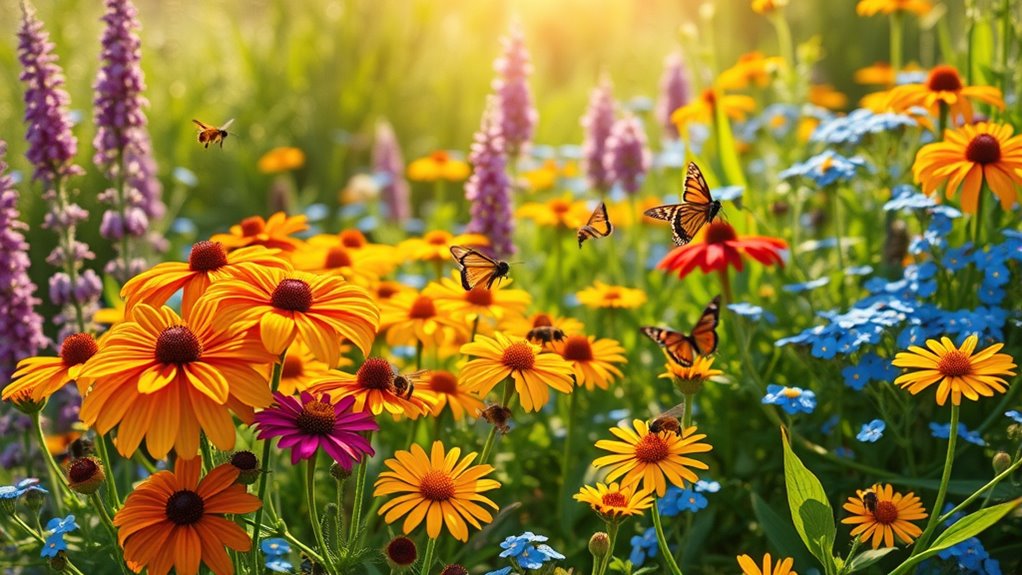
When selecting a native pollinator seed mix, I focus on species compatibility and bloom timing to guarantee continuous food sources. It’s also important to take into account how well the seeds match my local climate and soil conditions for successful growth. Finally, I look at seed quality and purity to guarantee healthy plants that attract a diverse range of pollinators.
Native Species Compatibility
Choosing the right native species for your pollinator seed mix is essential to support local ecosystems effectively. I recommend selecting species that are compatible with your area’s native plants, ensuring they fit well within the local environment. It’s important to verify that the seeds are adapted to your soil type, climate, and planting zone, which helps promote healthy growth and boosts biodiversity. Using native wildflowers and grasses that are indigenous to your area provides the appropriate food and habitat for local pollinators. Additionally, including a variety of flowering species that bloom at different times ensures nectar is available throughout the pollination season. To confirm compatibility, I suggest consulting native plant guides or local conservation agencies—they have valuable resources to guide your choices.
Bloom Timing and Duration
Selecting a seed mix that includes species with varied bloom periods is essential for providing pollinators with a consistent food source throughout the growing season. By choosing both early- and late-blooming wildflowers, you extend nectar availability from spring to fall, supporting pollinator health year-round. The bloom duration of individual species can range from a few days to several weeks, so a diverse mix maximizes overall flowering time. Understanding the typical bloom periods of your selected species helps ensure their flowering aligns with local pollinator activity peaks. A well-planned seed mix with staggered bloom times also enhances ecological resilience, providing reliable floral resources despite changing weather conditions and year-to-year variations. This strategic approach keeps your garden buzzing and your pollinators thriving.
Pollinator Attraction Range
To effectively attract a diverse range of pollinators, it’s important to contemplate how flower characteristics influence their preferences. Different seed mixes are tailored to attract specific pollinators, such as bees, butterflies, or hummingbirds, depending on the flower species included. The attraction range is shaped by factors like flower color, shape, size, and blooming period—each targeting particular species or supporting a broad spectrum. Native seed mixes, adapted to local climates and soils, enhance their effectiveness in drawing regional pollinators. Including a variety of plant species with staggered bloom times ensures continuous resources and extends the attraction window. Selecting mixes with diverse flowers and bloom periods promotes ecosystem health, supporting a wide array of pollinators throughout the growing season.
Climate and Soil Fit
When planning a native pollinator seed mix, it’s important to take into account how well the plants will thrive in your site’s climate and soil conditions. I recommend selecting species adapted to your region’s climate zones, such as USDA zones 3-8 or 3-10, for better growth and resilience. Match the seed mix’s moisture needs with your soil type—whether it’s well-drained sandy soil or loamy, moderately moist soil. Also, consider your local temperature ranges and planting seasons; spring and fall are typically ideal for germination. Make certain the bloom periods align with your climate’s active seasons so pollinators have nectar when they need it most. Finally, choose species capable of handling environmental stresses like drought or heavy rain to create a sustainable habitat.
Seed Quality and Purity
Ensuring the seed mix’s quality and purity directly impacts the success of your native pollinator planting. High-quality mixes should contain 100% pure, non-GMO seeds with no fillers, which promotes better germination and vigorous growth. Seed purity is essential; look for mixes that specify the absence of artificial ingredients or invasive species to support native plants and protect local ecosystems. Reputable brands often provide detailed labels certifying seed purity, composition, and adherence to organic or eco-friendly standards. Choosing pure, high-quality seeds minimizes the risk of introducing invasive species and guarantees your garden supports native pollinators effectively. Investing in good seed quality is a pivotal step toward establishing a thriving, sustainable habitat that benefits both your garden and the local environment.
Maintenance and Growth Needs
Choosing the right native pollinator seed mix depends heavily on understanding your local climate and soil conditions, as these factors directly influence plant growth and maintenance needs. Selecting species adapted to your region’s rainfall and sunlight reduces watering and fertilization requirements. I recommend choosing perennial varieties, which offer long-term blooms and lessen the need for reseeding or replanting. It’s also important to think about the growth habits and mature height of plants to prevent overcrowding and make maintenance easier. Additionally, including species with varying bloom times ensures continuous pollinator forage, minimizing extra planting efforts. By matching your seed mix to your environment and planning for manageable growth, you’ll create a thriving, low-maintenance pollinator garden that supports local ecosystems.
Ecological and Environmental Impact
Selecting native pollinator seed mixes can considerably benefit local ecosystems by providing habitat and food sources that are specifically suited to regional pollinators. I’ve found that planting native seeds helps maintain biodiversity and prevents invasive species from taking over, which keeps the environment balanced. Plus, native wildflowers typically need fewer chemicals like pesticides and fertilizers, reducing pollution and supporting healthier soil and water. These plants often have deep roots that stabilize the soil, preventing erosion and improving land resilience. Supporting native plants also sustains pollinator populations, which are essential for pollinating wild and crop plants alike. Overall, choosing native mixes not only boosts garden significance but also promotes ecological health and resilience, making your garden a crucial part of the local environmental fabric.
Cost and Availability
When considering native pollinator seed mixes, cost and availability play a crucial role in planning your project. I recommend comparing the price per pound or seed packet to stay within your budget, especially for larger areas. Check multiple sources—local garden centers, online suppliers, and bulk vendors—to guarantee the seeds are readily available and won’t delay planting. Look for seasonal sales, discounts, or bulk purchasing options to save money on bigger projects. It’s also important to verify that the seed mix remains in stock, so you don’t face shortages that could set back your timeline. By comparing costs and availability across suppliers, you can find a balance between affordability and reliable access, making your pollinator garden both budget-friendly and successful.
Frequently Asked Questions
Which Seed Mix Is Best for Attracting Specific Pollinators Like Butterflies or Hummingbirds?
If you want to attract butterflies, I recommend a seed mix with milkweed, butterfly weed, and coneflowers—they love these nectar-rich plants. For hummingbirds, I suggest a mix featuring bee balm, salvia, and trumpet creeper, which provide abundant nectar. I always choose native mixes tailored to my area’s pollinators, ensuring I support their needs while creating a vibrant, lively garden that attracts and sustains these beautiful creatures.
How Do Soil Types Influence Seed Mix Success and Germination Rates?
Soil types play a huge role in seed mix success and germination rates. I’ve learned that well-draining soil prevents root rot, while loamy soil offers the perfect balance of nutrients and moisture. For sandy soil, I add organic matter to retain moisture, and for clay, I improve drainage. Understanding your soil helps me choose the right mix and gives my native plants the best start, boosting pollinator attraction.
What Is the Optimal Planting Season for These Native Seed Mixes?
Think of planting native pollinator seed mixes as timing a symphony—spring or early summer is ideal. I recommend sowing after the last frost, usually March or April, depending on your region. This gives your seeds a head start during the active growing season when bees, butterflies, and hummingbirds are most enthusiastic to visit. Proper timing guarantees lush blooms and a vibrant, buzzing garden all season long.
How Much Area Can I Cover With One Pound of Seed Mix?
With one pound of seed mix, I can typically cover about 200 to 400 square feet, depending on the seed variety and planting density. I always recommend reading the seed packet instructions for specific coverage details. To get the best results, I make sure to prepare the soil well and spread the seeds evenly. This way, I maximize coverage and attract more pollinators to my garden.
Are There Any Maintenance Tips to Ensure Long-Term Pollinator Garden Health?
Think of your pollinator garden as a delicate symphony that needs tuning. To keep it thriving, I mulch to retain moisture and prevent weeds, deadhead spent blooms to encourage new growth, and water deeply during dry spells. I also prevent pests naturally and avoid over-fertilizing, which can harm pollinators. Regularly observing helps me catch issues early, ensuring my garden remains a vibrant, buzzing haven for pollinators year-round.
Conclusion
Choosing the right native pollinator seed mix is like planting a symphony in your garden—each flower a note that attracts buzzing friends. By selecting one that suits your region and needs, you’re not just growing plants; you’re creating a lively sanctuary that supports pollinators and enriches your outdoor space. So, get ready to watch your garden come alive with a vibrant melody of nature’s busiest performers!
